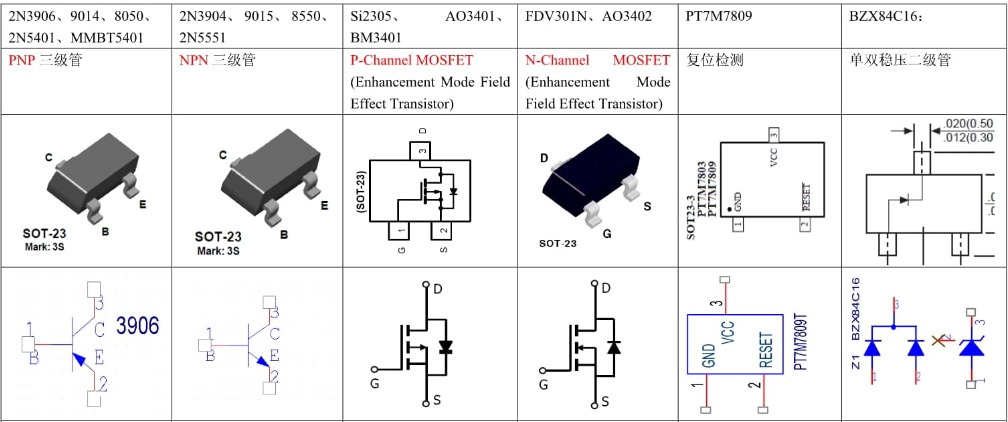Beginner’s Guide to Identifying SOT-23 IC Markings WTS 34

Identifying components such as the SOT-23 IC with markings like WTS 34 can be quite challenging due to their small size and often cryptic codes. Mastering transistors diodes identification is essential for ensuring the proper assembly of SMD components. Misreading these markings can result in significant errors in circuit design. Gaining a clear understanding of these codes not only streamlines the process of identifying SMD parts but also boosts the reliability of any chip-based project. This expertise enables both enthusiasts and professionals to confidently select the right components for their specific needs.
Key Takeaways
Knowing SOT-23 IC markings helps you find parts correctly. This avoids mistakes in building circuits.
Use magnifying tools to see tiny markings better. Tools like jeweler's loupes make it easier to spot parts.
Check markings with datasheets or online sources to confirm them. This helps you pick the right part.
Make your own list of common SMD parts. This will save time when identifying parts later.
Always check a part's details before using it. Correct identification stops problems and keeps circuits safe.
Basics of SOT-23 IC Markings
What Are SOT-23 IC Markings?
SOT-23 IC markings are alphanumeric codes printed on the surface of small-outline transistor (SOT-23) packages. These markings serve as identifiers for the specific component housed within the package. The SOT-23 package is a compact, surface-mount device (SMD) commonly used in modern electronics. It features a small footprint and is available in variants with 3, 5, 6, or 8 pins. The markings provide critical information, such as the manufacturer, part number, and sometimes the date code or batch number.
For example, the marking "WTS 34" could represent a specific transistor or diode, depending on the manufacturer. Identifying parts accurately requires understanding these codes and cross-referencing them with datasheets or online databases. The table below highlights key features of the SOT-23 package:
Feature | Description |
|---|---|
Package Type | SOT-23 (Small Outline Transistor 23) |
Pin Count | Variants include 3, 5, 6, and 8 pins |
Pin Pitch | 0.95mm for 3, 5, and 6 pin variants; 0.65mm for 8 pin variant |
Thermal Resistance | High-current devices may use multiple pins for improved thermal performance |
JEDEC Designator | R-PDSO-G for all SOT-23 variants |
Why Are These Markings Crucial for SMD Components?
Markings on SOT-23 ICs play a vital role in ensuring the correct identification of SMD components. Misidentifying parts can lead to circuit malfunctions or even permanent damage to the chip. These markings allow engineers and hobbyists to verify the component's specifications and compatibility with their designs.
Several methods aid in identifying parts accurately:
Visual inspection of the package marking and physical characteristics, such as pin count.
Using component testers to determine the type and pin configuration of the device.
Consulting datasheets for detailed electrical characteristics and manufacturer codes.
Leveraging online databases to search for components based on their markings and package type.
These steps ensure that the selected component matches the intended application, reducing the risk of errors in circuit assembly.
Common Issues in Decoding SOT-23 Markings
Decoding SOT-23 markings can be challenging due to their small size and the lack of standardization across manufacturers. Some common issues include:
Faded or unclear markings: Prolonged use or improper storage can cause markings to wear off, making identification difficult.
Ambiguous codes: Different manufacturers may use similar codes for entirely different components, leading to confusion.
Limited resources: Not all markings are documented in publicly available datasheets or online databases.
To overcome these challenges, users can employ magnification tools for better visibility and cross-reference markings with multiple sources. Building a personal reference library of commonly used SMD components can also streamline the identification process.
Step-by-Step Guide to SOT23 Marking Identification

Locating the Marking on the IC
Identifying the marking on a SOT-23 IC begins with a careful visual inspection of the chip. Manufacturers use specific guidelines to indicate the orientation of the pins and the location of Pin 1. These markings help users correctly position the component during assembly. Common marking types include notches, dimples, beveled edges, and text. Each marking type corresponds to a specific orientation, as shown in the table below:
Marking Type | Description |
|---|---|
Notch | Pin 1 is at the bottom left corner when the notch is on the left side. |
Bottom-side beveled edge | Pin 1 is at the lower-left corner when positioned with the chamfered edge as the bottom edge. |
Left side beveled edge | Pin 1 is in the lower-left corner when positioned with the beveled edge on the left side. |
Dimple | Pin 1 is at the lower-left corner when the dimple is on the left side. |
Strip | Pin 1 is located at the bottom left corner when the band is on the left. |
Text | Pin 1 is at the lower left corner when the text is upright and legible. |
QFN | Pin 1 marking may have a notch or chamfer in the exposed pad corner. |
BGA | Pin 1 marking will have a circle on it. |
Ribbon cable | Pin 1 is usually located on one edge of the cable. |
Users should always refer to the manufacturer’s datasheet for precise guidance on locating the marking. Magnification tools, such as a jeweler’s loupe or a digital microscope, can enhance visibility when markings are faint or unclear.
Decoding the Manufacturer Code
Once the marking is located, decoding the manufacturer code becomes the next step. These codes are alphanumeric identifiers that vary across manufacturers. They provide essential information about the component, including its type, function, and specifications. For example, the marking "WTS 34" might represent a specific transistor or diode, depending on the manufacturer.
To decode the marking codes, users can follow these steps:
Identify the alphanumeric code printed on the SMD package.
Cross-reference the code with the manufacturer’s datasheet or online databases.
Verify the component’s specifications, such as voltage ratings, current capacity, and pin configuration.
Manufacturer websites often provide detailed datasheets that list the codes used for their components. Online databases, such as SMD Codebook, can also assist in decoding unfamiliar markings. Accurate decoding ensures the correct identification of the chip and prevents errors in circuit design.
Using Datasheets and Reference Tables for Identification
Datasheets and reference tables are indispensable tools for identifying SOT-23 markings. Datasheets contain detailed information about the component, including its electrical characteristics, pin-outs, and marking codes. Reference tables simplify the identification process by listing common chips and their corresponding markings. Below is an example of a reference table:
Chip | Marking |
|---|---|
NSC | |
LMC7101 | A00A, A00B, AT6A |
To use datasheets effectively:
Locate the datasheet for the specific component by searching the manufacturer’s website or online databases.
Match the marking code on the SMD package with the codes listed in the datasheet.
Confirm the pin configuration and electrical specifications to ensure compatibility with the circuit design.
Reference tables provide a quick way to identify commonly used components, saving time during the assembly process. For less common chips, datasheets remain the most reliable source of information.
Practical Example: Decoding WTS 34

Understanding What WTS 34 Represents
The marking "WTS 34" on a SOT-23 IC provides essential information about the chip's identity and functionality. This alphanumeric code is unique to the component and helps users determine its type, specifications, and manufacturer. For instance, "WTS" may indicate the manufacturer or a specific product line, while "34" could represent a particular model or version.
Understanding what "WTS 34" represents requires referencing reliable sources. Manufacturers often use proprietary codes, so the same marking might signify different components depending on the brand. For example, "WTS 34" could identify a transistor, diode, or voltage regulator. Without proper identification, using the wrong component could lead to circuit failure or damage.
To decode this marking, users should first identify the manufacturer associated with "WTS." This step narrows down the possibilities and ensures accurate identification. Once the manufacturer is known, the next step involves verifying the component's specifications, such as voltage rating, current capacity, and pin configuration. These details are crucial for ensuring compatibility with the intended application.
Finding the Relevant Datasheet for WTS 34
Locating the correct datasheet is a critical step in decoding "WTS 34." A datasheet provides comprehensive information about the component, including its electrical characteristics, pin layout, and recommended usage. To find the relevant datasheet, users can follow these steps:
Identify the Manufacturer: Search for the company associated with the "WTS" marking. This information is often available on the manufacturer's website or through online databases.
Search Online Databases: Use platforms like SMD Codebook or Octopart to search for "WTS 34." These databases compile marking codes and their corresponding datasheets.
Visit Manufacturer Websites: Many manufacturers provide datasheets for their components directly on their websites. Searching for "WTS 34" in the product catalog can yield the desired document.
Verify the Information: Cross-check the datasheet details with the marking on the SOT-23 package. Ensure the pin configuration and specifications match the intended application.
For example, if "WTS 34" corresponds to a specific NPN transistor, the datasheet will confirm its maximum collector current, voltage rating, and power dissipation. This information helps users integrate the component into their circuit design with confidence.
Troubleshooting Faded or Unclear Markings
Faded or unclear markings on SOT-23 ICs can complicate the identification process. Over time, markings may wear off due to handling, environmental factors, or prolonged use. When faced with this challenge, users can employ several strategies to identify the component:
Use Magnification Tools: A jeweler's loupe or digital microscope can enhance visibility and reveal faint markings. Adjusting the lighting angle can also improve clarity.
Inspect the Package Marking: Examine the physical characteristics of the SOT-23 package, such as pin count and orientation. These features can provide clues about the component's identity.
Test the Component: Use a multimeter or component tester to determine the type and pin configuration of the device. For example, testing a transistor can reveal whether it is NPN or PNP.
Consult Reference Tables: Cross-reference the visible portion of the marking with online databases or personal reference materials. Partial codes can sometimes narrow down the possibilities.
Seek Expert Assistance: Community forums and expert networks can provide valuable insights. Posting a clear image of the component and describing its application can help others identify it.
By combining these methods, users can overcome the challenge of faded or unclear markings and ensure accurate identification. Building a personal reference library of commonly used SMD components can also streamline future troubleshooting efforts.
Tools and Resources for SOT-23 IC Identification

Online Databases for SMD Markings
Online databases simplify the process of identifying small SMD parts by providing a centralized repository of marking codes. These platforms allow users to search for specific codes, such as "WTS 34," and retrieve detailed information about the chip. Popular databases like SMD Codebook and AllTransistors offer extensive libraries of package marking codes. Users can input the code printed on the component and receive data about its type, manufacturer, and specifications. These tools save time and reduce errors during the identification process.
Some databases also include user-contributed entries, which expand their coverage of less common components. However, users should verify the accuracy of the information by cross-referencing it with other sources, such as datasheets or manufacturer websites.
Manufacturer Websites and Datasheets
Manufacturer websites serve as reliable sources for identifying SOT-23 ICs. These sites often provide datasheets that contain comprehensive details about their components. By searching for the marking code on the manufacturer's website, users can access information about the chip's electrical characteristics, pin configuration, and recommended applications. For example, a search for "WTS 34" on the relevant manufacturer's site might yield a datasheet with all the necessary specifications.
Datasheets are particularly useful for confirming the compatibility of a component with a specific circuit design. They also include diagrams and tables that clarify the pin layout and other critical details. Bookmarking frequently used manufacturer websites can streamline future searches.
Community Forums and Expert Networks
Community forums and expert networks offer valuable support for identifying SOT-23 IC markings. Platforms like Reddit's electronics subreddit or the EEVblog forum connect users with experienced hobbyists and professionals. Posting a clear image of the component and describing its application can prompt helpful responses from the community.
These forums often include discussions about obscure or outdated components that may not appear in online databases or datasheets. Expert networks, such as LinkedIn groups for electronics engineers, can also provide insights into identifying rare or custom-marked chips. Engaging with these communities fosters knowledge sharing and builds a personal network of resources for future projects.
Tips for Accurate Transistors Diodes Identification

Cross-Referencing Markings with Multiple Sources
Cross-referencing is a crucial step in transistors diodes identification. Relying on a single source can lead to errors, especially when dealing with ambiguous or proprietary markings. To ensure accuracy, users should consult multiple resources, such as manufacturer datasheets, online databases, and reference books. For example, if a marking like "WTS 34" appears on a chip, verifying it across several sources can confirm its identity and specifications.
Online platforms like SMD Codebook or AllTransistors provide extensive databases for SMD markings. Manufacturer websites often include datasheets with detailed information about their components. Community forums can also offer insights, especially for rare or outdated parts. Combining these resources minimizes the risk of misidentification and ensures the correct component is used in the circuit.
Using Magnification Tools for Better Visibility
The small size of SOT-23 ICs makes their markings difficult to read with the naked eye. Magnification tools, such as jeweler’s loupes, digital microscopes, or USB magnifiers, can significantly enhance visibility. These tools allow users to inspect faint or partially faded markings, ensuring accurate transistors diodes identification.
Proper lighting is equally important. Adjusting the angle of light can reduce glare and highlight the marking more clearly. For best results, users should work in a well-lit environment and use tools with adjustable magnification levels. This approach ensures that even the smallest details are visible, reducing the likelihood of errors during identification.
Building a Personal Reference Library for SOT-23 ICs
Creating a personal reference library is a practical way to streamline the identification process. This library can include datasheets, reference tables, and notes on commonly used components. For instance, users can document details about frequently encountered chips, such as their markings, pin configurations, and specifications.
Organizing the library by component type or manufacturer makes it easier to locate information quickly. Digital tools, such as spreadsheet software or note-taking apps, can help maintain and update the library efficiently. Over time, this resource becomes invaluable for both beginners and experienced professionals, simplifying the process of transistors diodes identification and ensuring accurate results.
Understanding SOT-23 IC markings is essential for ensuring the correct identification of SMD components. Accurate decoding of markings like WTS 34 prevents circuit errors and enhances the reliability of electronic designs. By following a systematic approach—locating the marking, decoding the manufacturer code, and consulting datasheets—users can confidently identify components.
The tools and resources discussed, such as online databases and magnification tools, provide quantitative methods that improve accuracy. For example:
Evidence Type | Description |
|---|---|
Topography Measurements | Enhance precision by identifying unique surface contours and patterns. |
Error Rate Calculation | Statistical analyses demonstrate the reliability of identification methods. |
Evolution of Methods | Transition to quantitative methods reduces uncertainty in identifications. |
Leveraging these resources ensures precise results, empowering users to tackle even the most challenging markings with confidence.
FAQ
What does "WTS 34" signify on a SOT-23 IC?
"WTS 34" is an alphanumeric marking that identifies a specific component, such as a transistor or diode. The letters and numbers often indicate the manufacturer and model. Users must cross-reference this code with datasheets or online databases for accurate identification.
How can beginners identify faded SOT-23 markings?
Tip: Use a magnifying tool like a jeweler’s loupe or digital microscope. Adjust lighting to improve visibility. If the marking remains unclear, test the component with a multimeter or consult online forums for assistance.
Are all SOT-23 markings standardized?
No, SOT-23 markings vary by manufacturer. Each company uses unique codes for its components. This lack of standardization makes cross-referencing datasheets and online databases essential for accurate identification.
What tools are essential for decoding SOT-23 markings?
Magnification tools: Digital microscopes or loupes
Online databases: Platforms like SMD Codebook
Datasheets: Manufacturer-provided documents
Component testers: Devices to verify type and pin configuration
These tools simplify the identification process.
Can incorrect identification damage circuits?
Yes, using the wrong component can cause circuit malfunctions or permanent damage. Accurate identification ensures compatibility and prevents costly errors. Always verify markings with multiple sources before integrating components into a design.
See Also
Simplified Guide For Integrating The SN74LVC4245APW Sensor
IRF820 N-Channel MOSFET For Power Management And Control
Understanding MC9S12DJ256MFUE Specs For Automotive Uses
User-Friendly Networking Guide For XILINX XC7K325T-2FFG676C
Streamlined Engine Control Solutions With SPC56 Microcontrollers
CALL US DIRECTLY
(+86)755-82724686
RM2508,BlockA,JiaheHuaqiangBuilding,ShenNanMiddleRd,Futian District,Shenzhen,518031,CN
www.keepboomingtech.com sales@keepboomingtech.com
